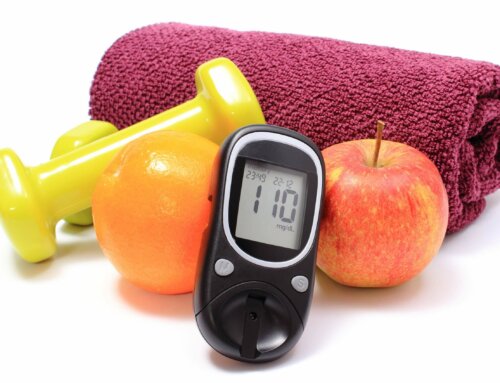We all know that exercise is important for everyone, and people with diabetes are no exception to that rule. Exercise helps control weight, regulates blood sugar levels, and improves circulation. Regular exercise can also reduce stress, cholesterol, and high blood pressure. If you’re ready to begin a new exercise routine, or if you’d like to reevaluate your current level of exercise, there is one question you might want to ask yourself: what kind of exercise is best for me, aerobic exercise or weight resistance training?
What is Cardio?
Aerobic exercise commonly referred to as cardio, raises the heart and breathing rate while working major muscle groups. Cardio increases insulin sensitivity and helps burn stored fat; it is recommended by most doctors for their patients with diabetes. Dancing, using the treadmill or elliptical, walking, swimming, aerobic classes, Zumba, tennis, basketball, and bicycling are all forms of aerobic exercise. You can also get a quick cardio workout by taking the stairs instead of the elevator. Wear a pedometer to keep track of your steps when walking and try to go a little further each day. Cardio offers all of the benefits mentioned above and is especially important for people with diabetes. Basic cardio workouts do little to increase muscle mass.
Benefits of Cardiovascular Training
Cardiovascular training helps burn calories. After changing eating habits as well, people with diabetes may lose weight and will maintain their healthier weight by doing aerobic exercise. More than 90 percent of people with diabetes are currently overweight or obese. Burning more calories than you consume can help you shed unwanted pounds. Losing weight may also reduce the risk of other diabetes-related health conditions, such as heart disease and stroke. According to a study in the Journal of Applied Physiology, “aerobic activity is the best type of exercise to burn fat and reduce body mass”. In one hour, a person can burn 250 plus calories based on the type of aerobic activity and the pace being maintained.
What is Weight Resistance Training?
To increase your overall fitness, the most effective way is to add weight resistance training to your cardio routine. Using dumbbells, bands, free weights or weight resistance machines two – three times a week can lead to a marked improvement in muscle gain over the long term. When you gain muscle and increase the metabolic rate, you increase the number of calories that you burn not only during your workout but all day long.
Another form of weight resistance training uses the weight of your body. Push-ups, crunches, lunges, squats, pull-ups, dips, and other body weight exercises require no special equipment and can be done in the privacy of your home. If you dislike the gym, body weight exercises may be the right option for you depending on your present strength. Many athletes such as gymnasts, martial artists, and wrestlers, use body weight exercises to develop a strong physique in proportion. Even the military uses body weight exercises to get new recruits into shape!
Weightlifting may enhance the benefits of aerobic exercise. This means the more muscle a person has, the more calories are being burned at rest as well as when exercising. Cardio and weight training are the perfect combination for optimal health. When done together, people with diabetes are building muscle, losing weight, and reducing their risk of heart disease and other diabetes complications.
The Best of Both Worlds
If weight resistance training is a challenge for you, try to incorporate cardiovascular exercises that are also weight-bearing. These include walking, stair climbing, jogging or elliptical training. This is referred to as cross-training which can be beneficial for everyone especially people with diabetes. Cross-training focuses on whole-body fitness with a mix of cardio, flexibility, and strength training. Using different muscle groups helps boost your level of fitness. Consider doing sets of 10, such as 10 minutes of walking, 10 minutes of resistance training or weight lifting, and stretching for 10 minutes. Make sure your exercises focus on all areas of your body including your core, legs, arms and back. It can be beneficial to work with a physical trainer for a few sessions to develop a workout routine that suits your fitness level and schedule. Senior centers, community centers and YMCA complexes may have group classes utilizing weight machines with demonstration and supervision as well.
Alternating between resistance training and cardio may be the answer to more effective diabetes management. Cross-training can lower blood sugar levels and reduce the risk of cardiovascular disease by up to 20 percent. It helps burn fat, build muscle, and make muscles more sensitive to insulin to help minimize the insulin resistance associated with diabetes.
Add Flexibility Exercise to Your Routine
To make your exercise routine well-rounded, flexibility exercises should be added. Stretching, Tai Chi, and yoga are excellent ways to increase or maintain flexibility and are gentle enough for anyone to do. Warming up before exercise and cooling down afterward helps prevent injuries and will allow you to get the most out of your workout.
Benefits of Stretching and Flexibility Exercises
There are many benefits associated with stretching and flexibility exercises. They help with range of motion which can be a problem for people with diabetes. Regular stretching helps prevent exercise-related injuries so you can do cardio exercises and weight resistance training with greater confidence. It also improves balance to help prevent falls.
Basic Exercise Rules to Follow
Before you jump into the next exercise trend, do your preliminary research. Whatever exercise you choose be sure to follow these basic rules.
Seek Medical Approval: Each body operates a little differently and every person with diabetes has his or her unique diabetes management plan. With that in mind, always check with your doctor before beginning any new exercise routine.
Monitor Your Blood Sugar Levels: Monitor your blood sugar level carefully, before, during, and after exercise. Keep glucose tablets and snacks available during workouts in case you experience a drop in blood sugar. Maintain a journal and share the results with your health care team during routine exams.
Check Your Feet: Whether you experience numbness in your feet or not, check your feet carefully every day for blisters, cuts, or other injuries. Be sure your footwear fits properly and offers as much support as you need. Wear socks when exercising at all times. If your shoes become worn, replace them regularly.
Now get on out there and exercise! Whether you choose cardio, weight resistance training, or a combination of the two, any exercise is of benefit to people with diabetes. And make sure to include stretching in your workout routine.








Leave A Comment